mobile View, to the German Version tap the flag


- Czech Republic, Czechia
- parliamentary republic
- own name: Ceska Republika (Cesko)
• Flags
• historical Flags
• Meaning/Origin of the Flag
• Map of the historical Czech lands
• Coat of Arms
• Meaning/Origin of the Coat of Arms
• Map of Czechia 1939–1945
• Map of today's Czechia
• Map of Silesia
• Numbers and Facts
• History
• Origin of the Country's Name
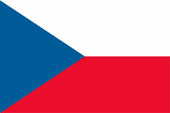
National- and merchant flag,
ratio = 2:3,
Source, by: Flags of the World





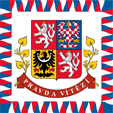
Standard of the President of Czechia,
Source, by: unknown, convert to SVG Tlusťa / Public domain




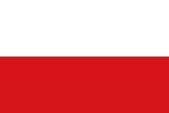
19th century,
Bohemian colours of the Czechs,
ratio = 2:3,
Source, by: Flaggen und Wappen der Welt



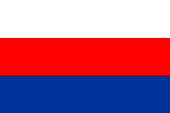
19th century,
Colours of the Slavs in Moravia,
ratio = 2:3,
Source, by:
Flaggen und Wappen der Welt



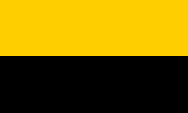
Colours of Czech Silesia (former Austrian Silesia),
ratio = 2:3,
Source, by: Flags of the World



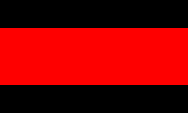
Colours of Sudetenland,
ratio = 2:3,
Source, by: Flags of the World






1990–1992,
Flag of the Czech Republic within Czechoslovakia,
ratio = 2:3,
Source, by: Flags of the World




The today’s flag of Czechia was officially introduced as flag of Czechoslovakia on 30th of March in 1920, and was taken over as flag of Czechia in preparation for the separation of Slovakia on 17th of December in 1992. It shows two horizontal stripes in white and red and on the pole a blue until the middle of the flag reaching isosceles triangle. The colours white and red are the since the 12th century known Bohemian colours (white lion on red), the blue triangle should today represent Moravia but former Slovakia. The colours of the flag are laid down in the "Act of the Czech National Council No. 3/1993 Coll. on the State Symbols of the Czech Republic with effect from 1st of January in 1993", but only as a colour sample imprint in Annex No. 3, without specifying colour values. The given colours are interpreted as follows: Blue = Pantone 293, Red = Pantone 485.
Many Slavic nations create on the 19th century own flags – in context with a growing Slavic nationalism. Thereby played the Panslavism an important roll, a political movement of the 18th/19th century, which would unite all Slavs in one nation. The most Slavic nations however lived in this times under Austrian, Turkish or even German rule. The Panslavism saw in Russia a model, because the Russians were, apart from Montenegro, the only free Slavic nation. In this way the colours of the Russian flag became to an idol of the Panslavists, and in the end to a colour's pattern in the designing of the flags of many Slavic nations. Those flags carried and carry except few exceptions the Russian colours white, blue and red as mutual attribute. From there this colour's combination is named "Panslavic Colours". The three colours had been shown for the first time in the year 1848 on the Slavic Congress in Prague, but in a lengthwise striped tricolour. They represented the Czech and the Slovaks.
Source: Die Welt der Flaggen,
Flaggen und Wappen der Welt,
Wikipedia (CS)

clickable
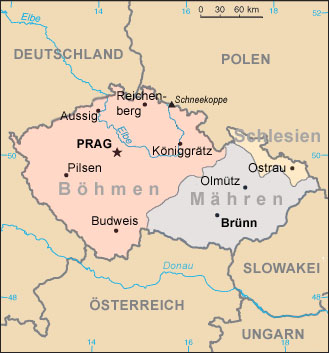
Source: CIA World Factbook, modyfied by: Volker Preuß


Coat of arms of Czechia,
Source, by: unknown, convert to SVG Tlusťa / Public domain

today's heraldry of Bohemia,
Source, by: unknown, convert to SVG Tlusťa / Public domain

today's heraldry of Moravia,
Source,
nach: unknown, convert to SVG Tlusťa / Public domain

today's heraldry of Czech Silesia,
Source,
nach:
unknown, convert to SVG Tlusťa / Public domain

The today’s coat of arms was adoped on 17th of December in 1992. It shows a quartered shield, in the first and fourth field the scutcheon of Bohemia (silvery double-tailed lion with golden crown on red ground), in the second field the scutcheon of Moravia (silvery-red chess-board styled eagle with with golden crown on blue ground), and in the third field the scutcheon of Silesia (golden crowned black eagle with a silvery by cloverleafs finished crescent with a small cross in the middle on golden ground).
Source: Flaggen und Wappen der Welt,
Volker Preuß

1939–1945
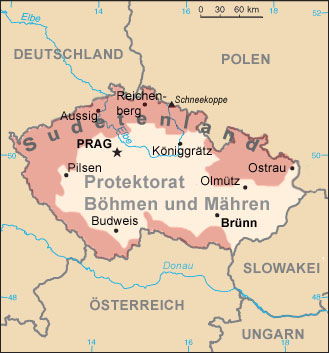
Source: CIA World Factbook, modyfied by: Volker Preuß
The Sudetenland – the area of settlement of the Germans – belonged directly to the German Empire, the area of settlement of the Czech was as "Protectorate of Bohemia and Moravia" subordinated unter German supremacy.

Location:
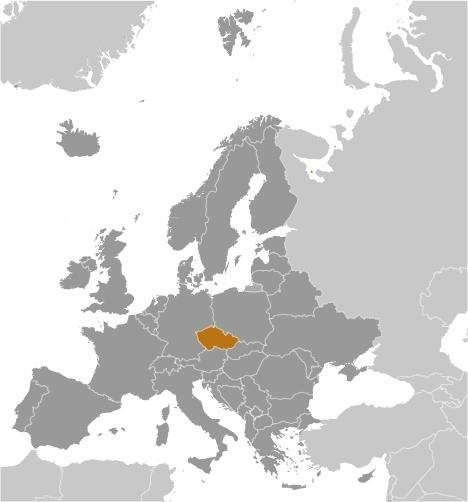
Source: CIA World Factbook
Map of the country:
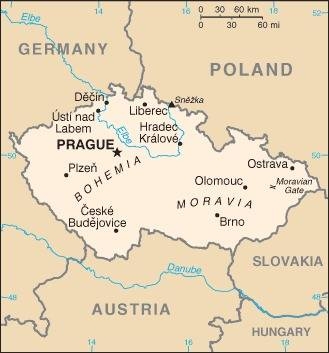
Source: CIA World Factbook
Names in German:
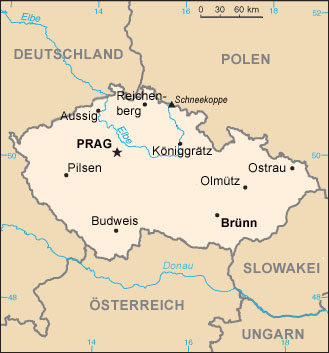
Source: CIA World Factbook, modyfied by: Volker Preuß

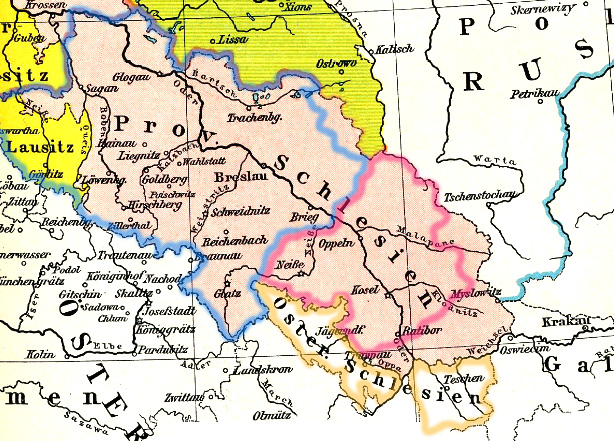
Source: F. W. Putzgers Historischer Schul-Atlas, modyfied by: Volker Preuß
The historical map shows Prussian Silesia between 1806 and 1815 as bright red area. The yellow areas in the Northeast have been ceded by Saxony to Prussia in 1815 and became connected to Silesia. Austrian Silesia (1742-1918) appears in a dark yellow outline. In the year 1919 Prussian Silesia became divided into two provinces, Upper Silesia (bright red outline) and Lower Silesia (bright blue outline).

Area: 30.450 square miles
Inhabitants: 10.637.800 (2018), thereof 90.5% Czech, 3.7% Moravian, 1.9% Slovak, 0.5% Polish, 0.5% Germans, 0.1% Gypsies
Density of Population: 349 inh./sq.mi.
Capital: Prag (Engl.: Prague, Czech: Praha), 1.308.630 inh. (2019)
official Language: Czech
other Languages: Slovakian, German
Currency: 1 Czech Koruna (Krone, CZK) = 100 Háleru (Heller)
Time Zone: GMT + 1 h
Source: Wikipedia (D)

History of Bohemia to 1918 (→ click here)
History of Moravia to 1918 (→ click here)
History of Austrian Silesia to 1918 (→ click here)
28th of October 1918 · formation of Czechoslovakia by merger of Bohemia, Moravia, Austrian Silesia, Slovakia and the Carpatho-Ukraine
29th of September 1938 · Czechoslovakia cedes Sudetenland to the German Empire
2nd of October 1938 · Poland occupys and annexes the Teschener Land
14th of March 1939 · the Slovak People's Party proclaims under Josef Tiso (1887–1947) the Slovakian Republic, disintegration of Czechoslovakia, Carpatho-Ukraine bekommes annexed by Hungary
15th of March 1939 · invasion of German troops, establishment of the Protectorate of Bohemia and Moravia
9th of May 1945 · takeover by ex-president Beneš, restoration of Czechoslovakia
1945–1948 · expulsion of 2,75 millions of Germans and hundred thousends of Hungarians with hundred thousends of dead persons
1992 · arrangements for dissolution of Czechoslovakia
1st of January 1993 · disintegration of Czechoslovakia, independence for Czechia and Slovakia
Source: Wikipedia (D),
World Statesmen,
Discovery '97,
Weltgeschichte

The name "Czechia" hs its roots in the name of the peolple of the Czech (Czechy), which immigrated together with other tribes to Bohemia in the 5th and 6th century and became to the here predominant slavic nation. "Czechy" means "crowds" or "troops".
Source: Atlas der wahren Namen,
Die Völker der Erde


![]()


































